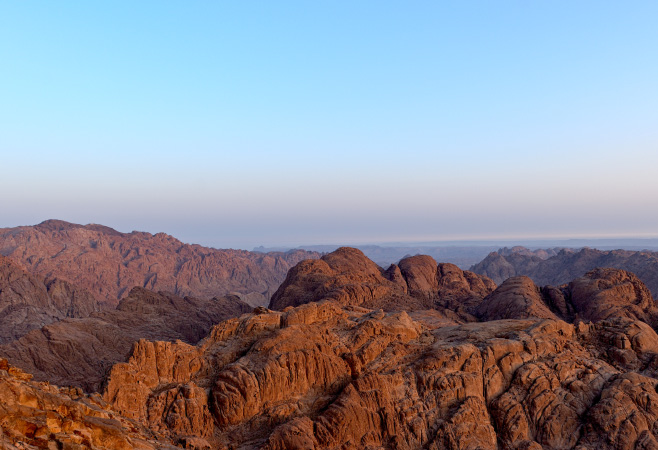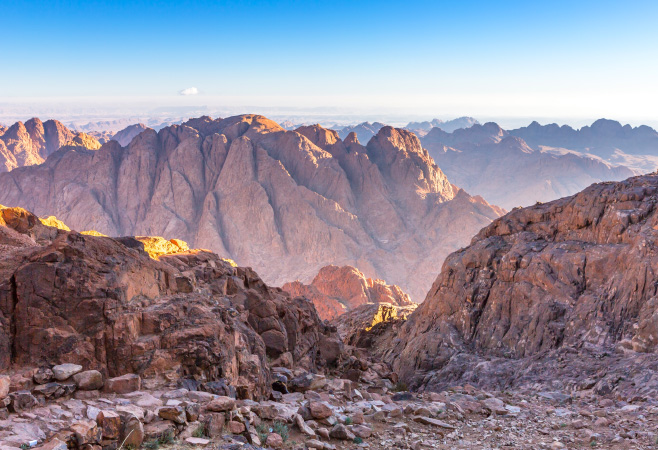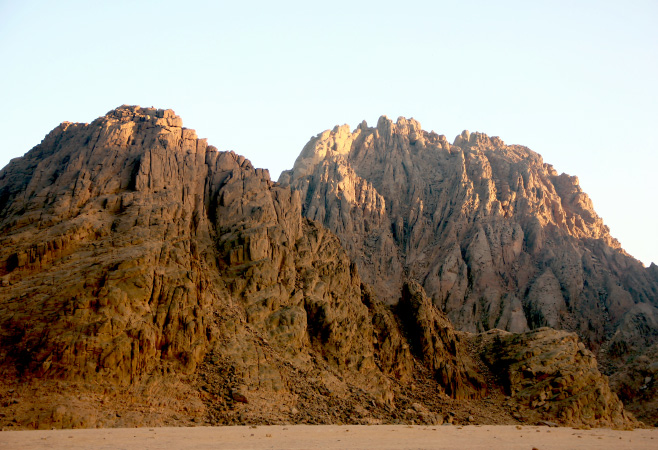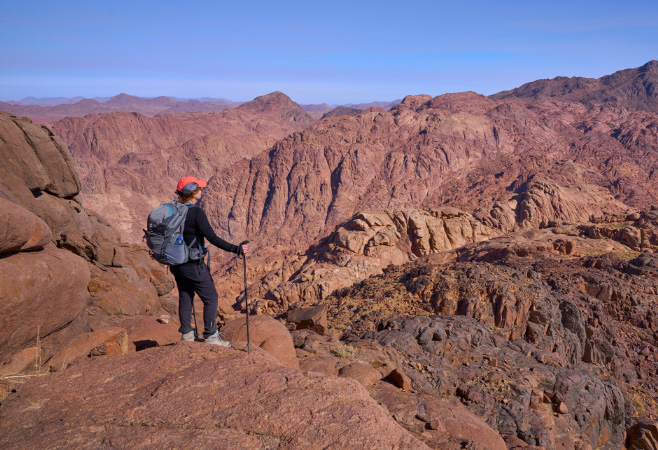Mount Serbal: Sacred Trails and Majestic Sinai Landscapes
Mount Serbal soars above Wadi Feiran in the Sinai Peninsula, reaching 2,070 meters, making it the fifth-highest mountain in Egypt. A combination of scattered granite boulders of the mountains, old Christian history, and a spectacular desert landscape make Mount Serbal a unique blend of historical, spiritual, and adventurous experiences for travelers who want to excursion off the beaten track in Egypt.

Get to know Mount Serbal better
Overview of Mount Serbal
Mount Serbal is a striking granite peak in Sinai, celebrated for its towering height, historic significance, and challenging hiking routes.
Location
Mount Serbal stands strikingly against the lush palm groves surrounded by green vegetation and the palm groves bordering the desert in Wadi Feiran, the largest oasis of southern Sinai.
It is located in St.Catherine National Park, where it is about 2,070 meters (6,791 ft), and it forms the fifth-highest mountain in Egypt.
Why to visit
Mount Serbal is more than just a striking granite peak in southern Sinai—it’s a destination where history, spirituality, and adventure converge.
- Historic and spiritual importance: Mount Serbal has considerable early Christian history. Its base is the site of ancient ruins of dwellings and a monastery that was built in the 4th century. In the trail and at the inscriptions in the Valley of Writing (Mokatteb) there are a few hints of early monastic life.
- Biblical connection: Mount Serbal is also supposedly the real Mount Sinai according to some scholars as supported by the elements of historical geography and ancient trade routes.
- Difficult and dramatic hike: Leaving Wadi Feiran, this steep and rocky trek has granite trails, high gullies and spectacular landscapes of the Red Sea, the Gulf of Suez and surrounding desert.
- Wild, spiritual atmosphere: The distant mountainsides are peaceful and thought provoking, combining natural beauty and centuries of history and spirituality.
Geographic
Mount Serbal is a dramatic granite peak in southern Sinai, blending striking natural features with a commanding presence over its desert surroundings.
- Amazing altitude: Mount Serbal is 2,070 meters (6,791 ft) high, making it the fifth-highest mountain in Egypt and the tallest in the region.
- Strategic site: Located in the largest oasis of the southern Sinai Wadi Feiran, Mount Serbal is an eye-catching view set of juxtaposed scenes of beautiful green palm trees in stark contrast with barren yellow sands.
- In a National Park: The mountain is within the boundaries of St. Catherine National Park, a national park that protects the mountain location to maintain a unique environment, ancient tourist attractions, and cultural sites around the region.
- Granite field: Made up of rough red granite, steep and rugged slopes and jagged prominent ridges forming an imposing front towards the open desert sky, the mountain itself is a granite massif.
- Spectacular views: Trekkers who reach its peak also enjoy panoramic views of the Red Sea, the Gulf of Suez, and the vast expanse of the Sinai desert.

Mount Serbal rises as a striking granite summit in southern Sinai
Climbing and hiking on Mount Serbal
Embarking on a hike up Mount Serbal is not for the faint of heart—it rewards adventurers with unforgettable landscapes and challenging terrain.
- Rugged and remote trail: Approaches are usually made either via Wadi Feiran or Wadi Aliyat and long, steep climbs (some almost all uphill) mean it is one of the most challenging climbs in Sinai.
- Multi-day adventure: Many trekkers choose a 2–3 day itinerary: setting up camp near Naqb Shaharani or basins along the route, such as Farsh Loz, allows for more manageable pacing and rest.
- Technical areas: Sections of the trail are narrow passages through saddles and comfortable rock scrambling that require proficiency, but there are no steep places to cross, and the route is generally of intermediate difficulty, roughly class II on the international climbing scale.
- Directional navigation: No established routes--cairns can be used as a guide--and there is no reliable GPS or cell service. It is necessary to employ a local Bedouin guide to navigate and locate hard to find water sources.
- Summit rewards: It is an impressive, and lonesome affair, reaching the peak offers panoramic views of Wadi Feiran, the Gulf of Suez, and of the scenic desert topography of Sinai.

Mount Serbal’s trails challenge the brave
After exploring Mount Serbal, adventure seekers should head to Gabal Sha'ib El Banat, a stunning mountain known for its rugged terrain and remote beauty.
How to get there
Reaching Mount Serbal requires careful planning and coordination, as it is set deep within southern Sinai’s rugged desert landscapes. Here’s how to make the journey smoothly:
- Fly into Sinai or Cairo: After flying into Sharm El-Sheikh or Cairo, continue your journey to Wadi Feiran by bus, private car, or 4×4 vehicle.
- Get to Wadi Feiran: Ride a 4×4 vehicle to the Wadi Feiran valley, the starting point of the trek. One would choose to reach the valley using car facilities of major towns such as St. Catherine or Dahab.
- Most hikers begin at the convent or palm groves in Wadi Feiran, then continue climbing through Wadi Aliyat to Naqb Shaharani.
- Take a Bedouin guide: No marked trails. This is made easy by a local Bedouin guide who will lead people safely and will assist in locating water, and give some inside on the terrain and the culture.
- Select a multi-day route: Many climbers plan for 2 – 3 days to reach the summit, camping along the way to divide the intense remote climb.
All you need to know before visit
Planning a trip to Mount Serbal? Make sure you're fully prepared with these essential insights:
- Permits and access: The mountain is in St. Catherine National Park, thus it is necessary to check prior to the trip with local authorities or tour companies.
- You need guided treks: Routes lack signs and the landscape is very jagged. It is important to hire a local Bedouin guide, as he will help navigate, as well as be safe and informative culturally.
- Time and topography: This is a multi-day trek (2-3 days). Routes contain rock climbs of high grades and increased elevation gain in a remote environment.
- Health and safety preparation: The climb is physically stressful. Bring along enough drinking water, sun block and go at a manageable speed- cell reception is poor.
- Best season: It is more comfortable to hike in the cooler months of the year (autumn through spring). In summer the temperature is heated.
- Cultural sensitivity: The region is spiritually deep rooted with ruins of early years Christian monastic life (remnants, hermit dwellings and inscriptions). During your visit respect the heritage.

Tips visit to Mount Serbal
Beyond Mount Serbal’s sacred trails, adventurers often journey to Mount Catherine, the highest peak in Egypt.
FAQs about Mount Serbal
Here are common questions and answers to help you understand Mount Serbal’s location, history, and hiking experience before your visit.
How high is Mount Serbal?
Mount Serbal rises to an elevation of 2,070 meters (6,791 feet) above sea level, making it the fifth-highest mountain in Egypt and a prominent peak in the Sinai Peninsula.
Is Mount Serbal historically significant for early Christianity?
Yes, Mount Serbal is historically significant for early Christianity, featuring ancient anchorite dwellings, remains of a 4th-century monastery, and Greek inscriptions along pilgrimage routes such as the Valley of Writing.
What are the trail conditions and requirements for hiking Mount Serbal?
Hiking Mount Serbal involves steep, rugged, and unmarked trails, often requiring 2–3 days. A local Bedouin guide is essential for safe navigation, route finding, and accessing scarce water sources.
To experience another side of Egypt’s natural beauty, visit the Wadi El Rayan Fayoum Falls, a protected area known for its stunning waterfalls and diverse wildlife.
In conclusion
To sum up, Mount Serbal can be regarded as a unique combination of the rugged natural beauty, strong spiritual heritage and challenging adventure in the heart of southern Sinai. It can be described as a historical mecca as its destinations feed a historian as well as a trekker; the ancient monasteries, breathtaking views of the desert. In the case of international visitors, prior online application of an Egypt e-Visa allows travelers to have a hassle-free experience to enjoy the worldly offerings of this magnificent and culturally rich mountain without any travel inconveniences.
Related Articles
- Business Visa Egypt – Requirements, Fees & How to Apply
- Student Visa Egypt Guide: Requirements, Fees & Process
- 5 Year Multiple Entry Visa Egypt: Full Guide & Updates
- How much is a visa from Nigeria to Egypt? Full cost guide
- Egypt Visa Extension: How to Apply, Requirements & Guide
- Egypt Transit Visa Guide: Requirements, Process & Tips











